- Perspective – March 2022
- Advert : Columbus Stainless
- Industry Insight – STAINLESS STEEL SECTOR GEARS UP FOR GROWTHEach year we ask Sassda Acting Executive Director Michel Basson to give us an overview of the sector’s performance in the last 12-months as well as some key information and insights. Here is his outlook on a year like no other and the bright spots of potential on the horizon… How would you categorise the performance of the South African stainless steel sector in the last two years with specific reference to the current performance where primary consumption levels have returned to 2018 levels? What has allowed that to occur? The performance of the local stainless steel industry has been confirmation of what we have seen during similar times of global economic crisis. It has once again shown adaptivity, innovation and resilience. Our sector was one of the first to be able to start up after the initial lockdown at 50% capacity compared to the 30% of most others. This was due to the sector’s ability to cooperate and organise quickly and intelligently. The industry certainly didn’t come through the past two years unscathed but it is showing pre-pandemic consumption levels. Please can you give some other meaningful stats in terms of how the…
- Advert – Unique Welding –
- Market Intelligence – THE BEST OF THE GPS E-NEWSLETTEREach month Sassda rounds up a selection of global and local market intelligence articles that are sent to our members in an easy to read package of content. They’re designed to highlight pockets of potential growth in demand for stainless steel. Here are some of the best articles from the last few issues… COAL FEET: LIMPOPO INDUSTRIAL PARK BACKED BY CHINA DITCHES PLANS TO BUILD POWER STATION The company overseeing the development of a proposed Chinese backed industrial park in Limpopo says it has ditched plans to build a coal power station and will instead use solar power. At a business briefing in Polokwane MMSEZ CEO Lehlogonolo Masoga said plans to build a coal-fired power plant to provide electricity for the hub’s proposed steel, coking and pig iron plants had been ditched. “Environmentalists said no. World leaders said no – [saying instead] let’s reduce our carbon footprint and stop producing energy through coal,” said Masoga. “We have abandoned that part of the project. We are now focusing on solar.” READ MORE
- Advertorial – Innov-X-Africa
- Advert – Innov-X-Africa
- What to Expect of Business in Africa in 2022
- Doing Business in Namibia – Namibia is strategically poised for stellar growth thanks to a substantial natural gas and oil discoveries off its coast. However, with a small opulation of approximately 2.6 million people, and a large land mass of 825 square kilometres and an immense distance to cover in terms of service and connectivity infrastructures, the country has its fair share of challenges… The Namibian government has a strong focus on the pursuit of free market economic principles to promote commercial development and job creation. Although a large portion of the population engages in more traditional subsistence farming and herding activities, the country also has a more modern market sector that is the largest contributor to its economy. The Namibian dollar was introduced in 1993 and is closely linked to the South African Rand at an exchange rate of 1:1. This makes its economic trajectory very similar to that of South Africa. AN EXTRACTION ECONOMY The mining, agriculture and tourism sectors have always been the traditional backbones of the economy with the success of the country being largely dependent on the extraction and processing of minerals for export. Almost 50% of the country’s foreign exchange earnings are derived from mining which makes up approximately…
- A picture of Tanzania looking Forward – The Tanzanian economy is experiencing rapid expansion with its GDP expected to grow from US$50-Billion in 2016 to $100-Billion in 2026, and his forecast may well be a conservative one as it excludes the recent oil and gas finds in Tanzania. It is projected that the Tanzanian GDP will grow from US$50 billion in 2016 to reach $100-Billion in 2026, but this excludes the recent oil and gas discoveries in Tanzania. Tanzania’s economy is reliant on agriculture, a sector that employs at least 65% of the workforce and accounts for just under a quarter of the GDP. As with most other countries, the COVID-19 pandemic stunted economic growth, resulting in a drop of 3% between 2020 and 2021. However, renewed focus on and reform in sectors such as agriculture, mining, manufacturing and construction will see the GDP bounce back to at least 6% in 2026. A stronger GDP is certainly needed in a population that is projected to grow from 58-million to at least 79-million by 2030. PROJECT PROFILE The East African Crude Oil Pipeline, at an estimated capital investment of $3.5-Billion, is a critical project between Tanzania and Uganda that is currently under construction. This project will unlock the…
- Professional Profile
- Case Study – 3CR12 IN ACTION IN THE SUGAR INDUSTRYThe global sugar sector is an increasingly competitive industry where cost reduction and increased productivity is of the essence. The ISSF reports that an assessment of the performance of basic stainless steel grades in the European sugar industry has shown that the use of these grades has led to a 50% drop in plant maintenance costs. Corrosion and rapid wear of factory equipment are widely recognised as the major contributors to production costs and quality problems in the sugar industry. The root cause of this is the fact that the processing of sugar cane is highly corrosive and/or abrasive. In the early years, producers of sugar almost exclusively used carbon steel in the plants. This design was based on the perceived low costs of the material. This was ultimately the incorrect decision since carbon steel does not have high resistance to either mechanism. The processing environment is created by a mixture of abrasive particles, moisture,heat, and acidity creating a very hostile environment for regular materials. However, to the utility ferritic this is home. BACKGROUND TO 3CR12 For historical reasons, users and potential users of stainless steel believed only austenitic grades with higher levels of…
- Membership – It is important for any organisation to be in tune with the market or, in Sassda’s case, its members. We have regular interaction with our members whether it be at sports days, training events or the meetings of our various structures. In 2021, we endeavoured to try and understand in more detail what members think of our products and their delivery. This information gathering process ultimately led to a strategic event during November 2021 where together with members, we reviewed our offering to date and considered what we can do to enhance the current offering. As background, it is important to appreciate that we have changed our funding model during 2019 and with this, a new range of product mixes was designed for the individual tiers. We were able to give members a 30% discount during 2020 when most of our members were heavily impacted by the hard lockdown. Most of our products are now delivered live and online and we wanted to get an idea of whether this new concept is working for members and adding value. The results of the members feedback were extremely positive and encouraging. Our “stone” membership tiers with mostly fabricating members, responded…
- Networking – SASSDA’S EASTERN CAPE GOLF DAY A SPARKLING SUCCESSSassda held its first Golf Day of 2022 in sparkling blue sunshine of a surprisingly wind-free Qheberha. 52 players relished the chance to get back to business in the real world and connect with industry colleagues in a productive and meaningful manner and in addition to some super shots, a number of key networking opportunities arose. Sassda would like to thank our sponsors Macsteel VRN, NDE, Columbus Stainless, SJM Flex and TÜV Rheinland without whom this stellar sporting event would not have been possible.
3CR12 IN ACTION IN THE SUGAR INDUSTRY
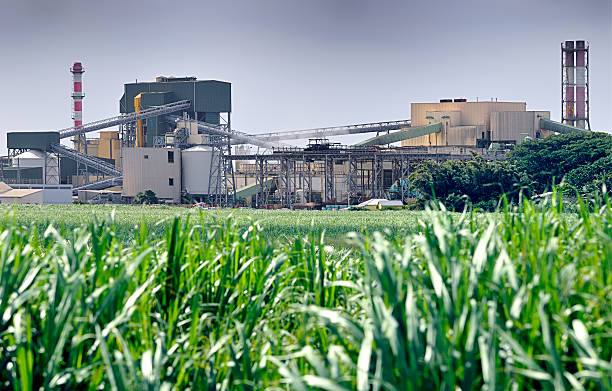 The global sugar sector is an increasingly competitive industry where cost reduction and increased productivity is of the essence. The ISSF reports that an assessment of the performance of basic stainless steel grades in the European sugar industry has shown that the use of these grades has led to a 50% drop in plant maintenance costs.
The global sugar sector is an increasingly competitive industry where cost reduction and increased productivity is of the essence. The ISSF reports that an assessment of the performance of basic stainless steel grades in the European sugar industry has shown that the use of these grades has led to a 50% drop in plant maintenance costs.
Corrosion and rapid wear of factory equipment are widely recognised as the major contributors to production costs and quality problems in the sugar industry. The root cause of this is the fact that the processing of sugar cane is highly corrosive and/or abrasive. In the early years, producers of sugar almost exclusively used carbon steel in the plants.
This design was based on the perceived low costs of the material. This was ultimately the incorrect decision since carbon steel does not have high resistance to either mechanism. The processing environment is created by a mixture of abrasive particles, moisture,heat, and acidity creating a very hostile environment for regular materials. However, to the utility ferritic this is home.
BACKGROUND TO 3CR12
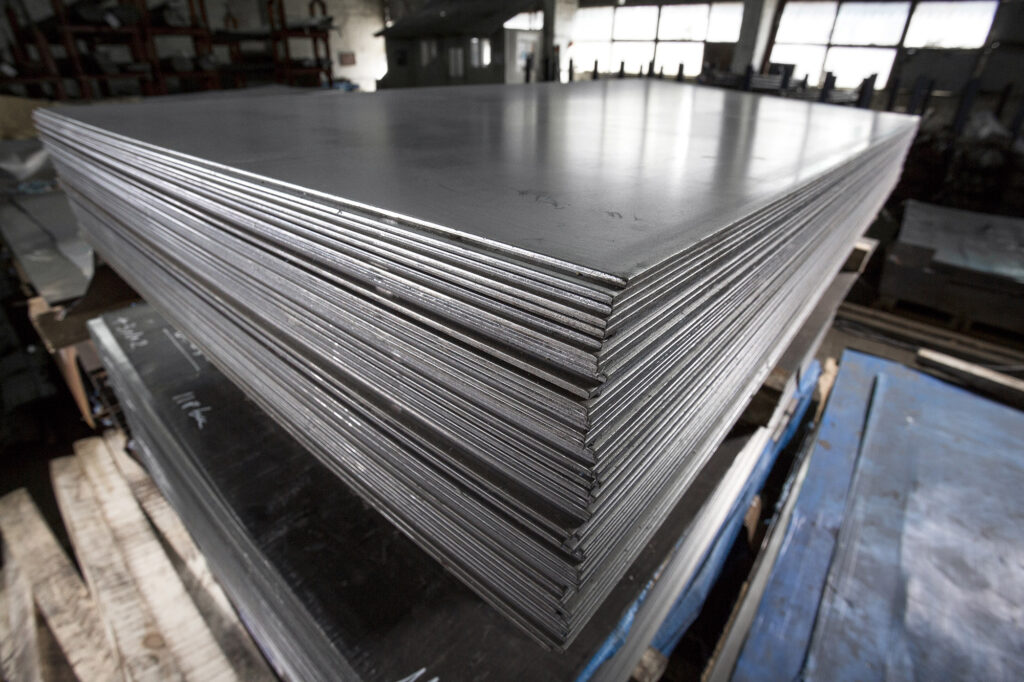 For historical reasons, users and potential users of stainless steel believed only austenitic grades with higher levels of chrome and nickel would be suitable for these types of environments. This is based on the false perception that nickel contributes mainly to corrosion resistance.
For historical reasons, users and potential users of stainless steel believed only austenitic grades with higher levels of chrome and nickel would be suitable for these types of environments. This is based on the false perception that nickel contributes mainly to corrosion resistance.
The truth is that nickel enhances weldability and ductility but does not contribute to corrosion resistance.
Nickel is also an expensive alloying element and contributes to the higher pricing of austenitic stainless steel (also known as the 300 series).
However, although ferritic grades offer a lower and more stable costing structure, not all ferritics are weldable to the required level for the industry. The locally developed utility ferritic known as 3CR12 would be the solution. 3CR12 is recognised as the original 12% chrome utility ferritic grade. Internationally 3CR12 is also designated as type 1.4003. Whilst ferritic grades are not readily weldable above 3mm gauge thickness, 3CR12 is a weldable ferritic utility stainless steel and is not normally prone to stress corrosion cracking as is the case with austenitic stainless steel. It is selected for its corrosion resistance, strength and toughness and is particularly suited to wet materials handling due to its ability to resist abrasion induced corrosion. 3CR12 was developed as a superior alternative to coated carbon steel, COR-TEN, and aluminium.
Examples of 3Cr12 in the sugar industry:
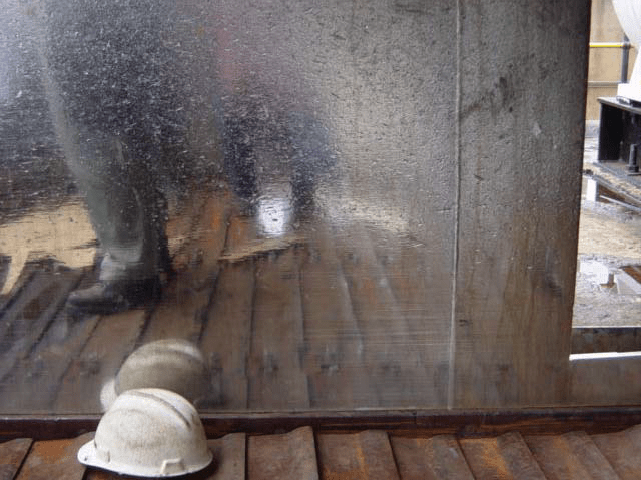
Figure 1
Figure 1 shows components of the main cane carrier. Note the reflectivity of 3CR12 sides polished by service since 1985. Originally designed from 10mm thick material, these sides still measure thicker than 9mm after 18 years of service. Records show that carbon steel would last a maximum of ten years in this application. This also illustrates the self-cleaning ability of 3CR12 and stainless steel in general.
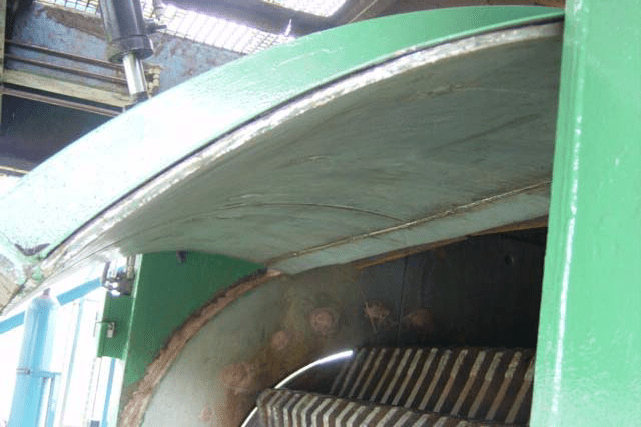
Figure 2
The cane carrier, often described as the cane conveyor, is the moving apron that conveys the cane to the factory and assures the feed to the mills by transporting the cane from the yard to the crusher. Figure 2 shows the exit from the cane carrier with 3CR12 visible on the inside of the opened lid. 3CR12 is also used on related equipment such as cane levellers.
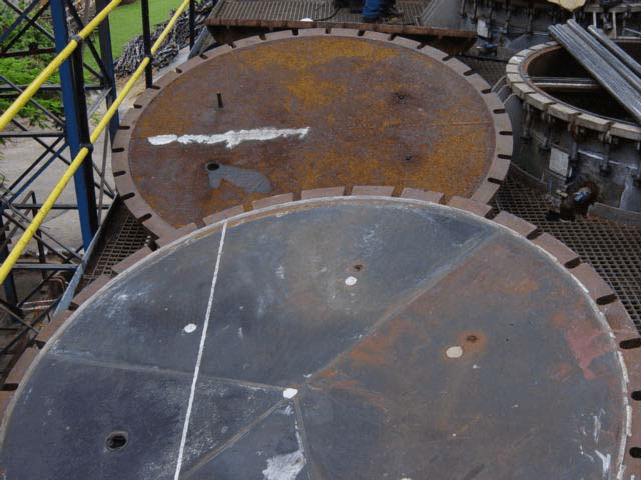
Figure 3
The juice heater consists of an assembly of tubes; the sugar cane juice circulates through the tubes and the vapour outside them. Suitable headers force the juice to pass a certain number of times from bottom to top and from top to bottom of the heater by restricting the juice each time to a few of the tubes.
A visual comparison between 3CR12 and mild steel on scalding juice heater covers is shown in Figure 3. Note the corroded condition of the mild steel of the unit at the back and the good condition of the 3CR12 cover in front. Both units have a similar life span.
In the sugar industry, a major component of the extraction process is a device known as a diffuser. Crushed and shredded cane is repeatedly washed by warm water as it travels along a conveyor, leaching the sugar from the cane. Similar evidence can be found at the diffusers where lids made from 3CR12, and mild steel can be compared over a similar service life. The two images in Figure 4 show the difference between the two grades. The picture on the left shows a 3CR12 lid on a diffusor after several years in service. On the right, is a lid made from mild steel after similar service life.
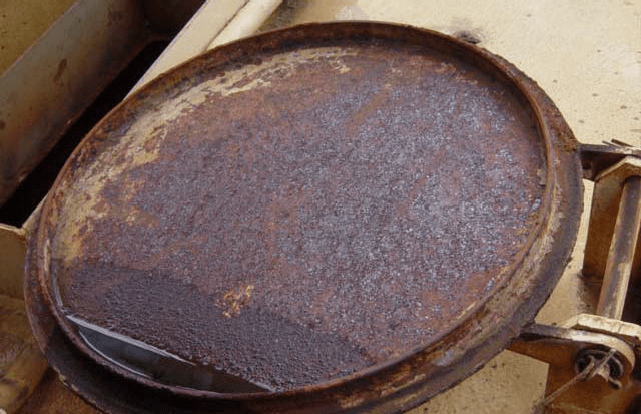
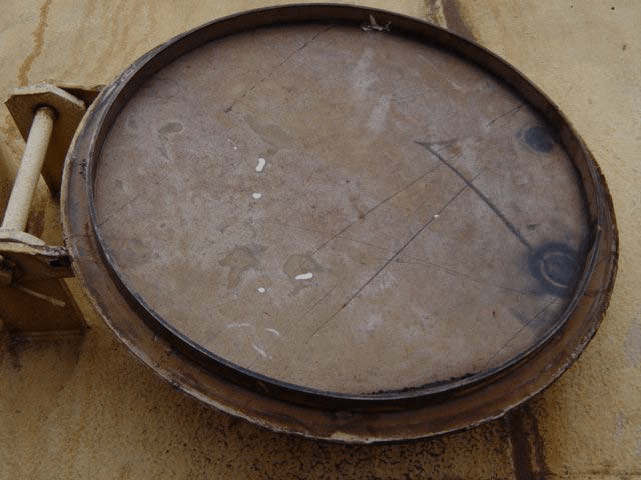
Figure 4
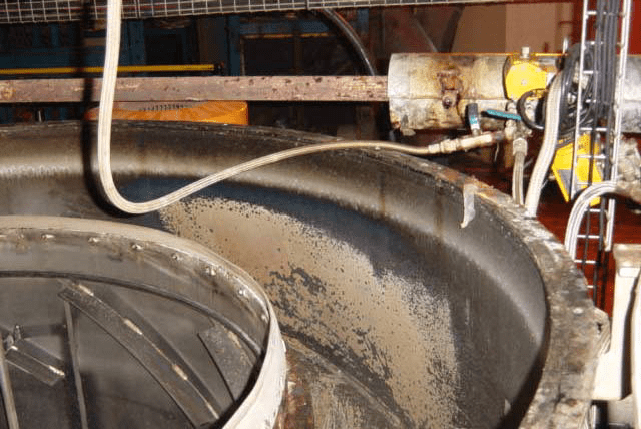
Figure 5
Centrifugation is a mechanical process, which has the function of separating or clarifying a mixture, from different densities of its components. The centrifuges used in the production of sugar are designed for processing massecuite, a mixture of sugar crystals and molasses, which is produced by the crystallisation phase of sugar refining. The centrifugal spins the massecuite in a perforated basket at speeds of up to 1200 rpm. 3CR12 is used for the centrifugal exterior and interior. Figure 5 depicts the 3CR12 interior of the centrifugal.
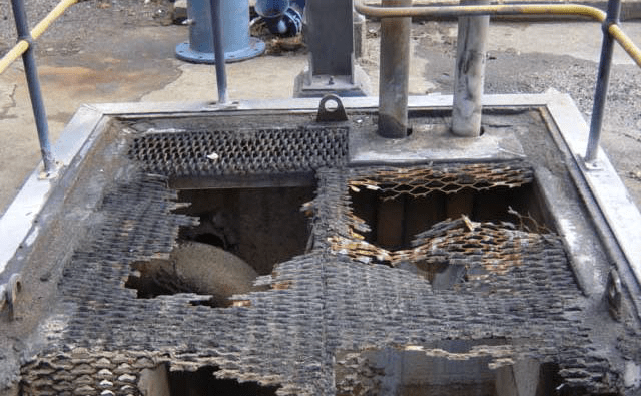
Figure 6
Effluent and wastewater handling suit the use of 3CR12. The remarkable difference in corrosion resistance offered by the utility ferritic is illustrated in Figure 6 showing a 3CR12 frame with a carbon steel grid. The frame and grid are the same functional age and while the grid is for all practical reasons destroyed, the frame remains in very good condition and even shines.
The two images in Figure 7 show in detail the different levels of corrosion for stainless steel (left) and carbon steel (right) grids installed at the same time and exposed to the same effluent.
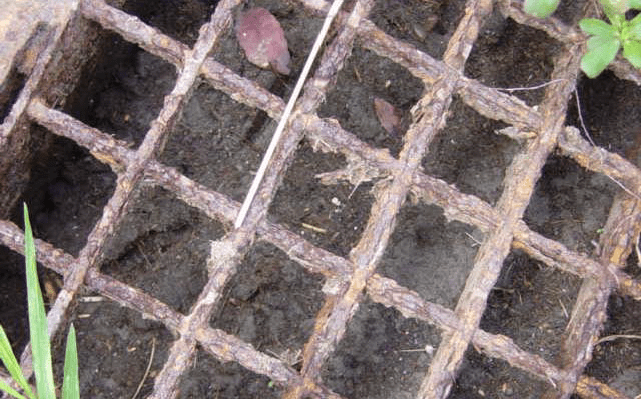
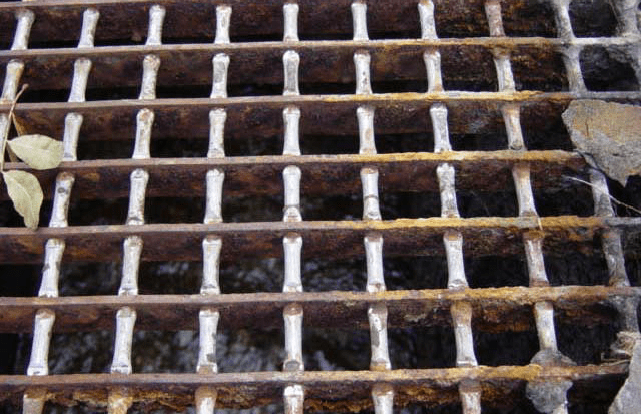
Figure 7
CONCLUSION:
Important lessons are to be learned through the experience of the sugar industry. It shows us the importance of having technical staff and process engineers aware and informed on proper grade selection, the mechanisms for corrosion and Life Cycle Costing. The informed person knows that stainless steel is unbeatable in virtually all applications and is Simply Brilliant!

